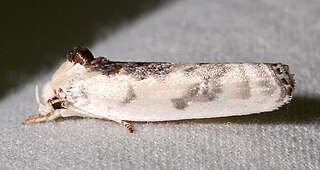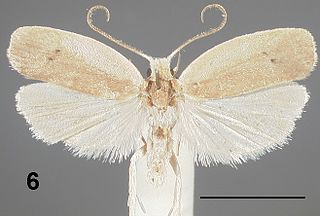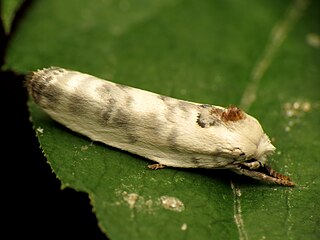
Antaeotricha is a genus of moths. It is the largest genus in the subfamily Stenomatinae, numbering over 400 species in the Western Hemisphere.

Antaeotricha osseella is a moth of the family Depressariidae. It is found in North America, where it has been recorded from New York, New Jersey, North Carolina, South Carolina, West Virginia, Maryland, District of Columbia, Massachusetts, Pennsylvania, Illinois, Arkansas, Missouri, Texas and California.

The Stenomatinae are a subfamily of small moths in the family Depressariidae.
Antaeotricha walchiana is a moth of the family Depressariidae. It is found in Venezuela, Panama, Trinidad, Colombia, French Guiana, Brazil, Bolivia and Peru.
Antaeotricha carabodes is a moth of the family Depressariidae. It is found in Guyana.
Antaeotricha spurcatella is a moth of the family Depressariidae. It is found in Guyana and Honduras.
Antaeotricha tectoria is a moth of the family Depressariidae. It is found in Guyana, French Guiana and Brazil.
Antaeotricha filiferella is a moth in the family Depressariidae. It was described by Francis Walker in 1864. It is found in Amazonas in Brazil and in Panama.
Antaeotricha fractilinea is a moth in the family Depressariidae. It was described by Lord Walsingham in 1912. It is found in Mexico (Tabasco).
Antaeotricha fumifica is a moth in the family Depressariidae. It was described by Lord Walsingham in 1912. It is found in Mexico.
Antaeotricha haesitans is a moth in the family Depressariidae. It was described by Lord Walsingham in 1912. It is found in Mexico (Durango) and the United States, where it has been recorded from Texas.
Antaeotricha elaeodes is a moth in the family Depressariidae. It was described by Lord Walsingham in 1913. It is found in Mexico.
Antaeotricha ergates is a moth in the family Depressariidae. It was described by Lord Walsingham in 1913. It is found in Mexico (Tabasco).
Antaeotricha forreri is a moth in the family Depressariidae. It was described by Lord Walsingham in 1913. It is found in Panama and Mexico (Durango).
Antaeotricha fascicularis is a moth in the family Depressariidae. It was described by Philipp Christoph Zeller in 1854. It is found in Guyana, French Guiana and Brazil (Amazonas).

Antaeotricha leucillana, the pale gray bird-dropping moth, is a moth in the family Depressariidae. It was described by Philipp Christoph Zeller in 1854. It is found in North America, where it has been recorded from New Hampshire, Massachusetts, New York, Pennsylvania, District of Columbia, Virginia, North Carolina, Georgia, Alabama, Arkansas, Missouri, Kansas, Illinois, Iowa, Texas, Oregon, Louisiana, Manitoba and Nova Scotia.
Antaeotricha humilis, the dotted anteotricha moth, is a moth in the family Depressariidae. It was described by Philipp Christoph Zeller in 1855. It is found in North America, where it has been recorded from Alabama, Arkansas, Florida, Georgia, Illinois, Indiana, Kansas, Kentucky, Louisiana, Maryland, Mississippi, New Jersey, North Carolina, Ohio, Oklahoma, South Carolina, Tennessee, Texas, Virginia and West Virginia.
Antaeotricha xanthopetala is a moth in the family Depressariidae. It was described by Edward Meyrick in 1931. It is found in Brazil.
Antaeotricha extenta is a moth in the family Depressariidae. It was described by August Busck in 1920. It is found in Guatemala and Panama.
Antaeotricha lindseyi is a moth in the family Depressariidae. It was described by William Barnes and August Busck in 1920. It is found in North America, where it has been recorded from California, Arizona and New Mexico.



